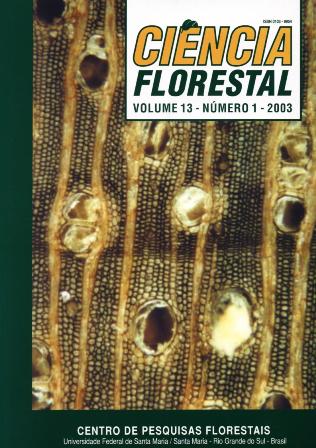Polyamines as salinity biochemical marker in callus of <i>Eucalyptus urograndis</i>.
DOI:
https://doi.org/10.5902/198050981722Palavras-chave:
micropropagation, salt stress, polyamines, <i>Eucalyptus</i>Resumo
Biochemical markers have been used for the analysis of plant cells submitted to several types of stress, among them salinity. This work aimed at analyzing the effect of saline stress in callus of Eucalyptus urograndis on polyamine contents. Explants (hypocotyls) obtained from seeds were inoculated in callus inductive medium, submitted to different levels of NaCl and analyzed at 10, 20 and 30 days after the inoculation. The free polyamines were extracted, isolated and quantified using TLC (Thin-Layer Chromatography). Putrescine content was higher and a fall in the spermidine content was observed in callus submitted to salinity condition. The results showed that polyamine accumulation is related to NaCl exposure in callus of Eucalyptus urograndis. The decrease in spermine content could be used as a biochemical marker for Eucalyptus callus subjected to salinity.
Downloads
Referências
ALI, R.M. Role of putrescine in salt tolerance of Atropa belladonna plant. Plant Science, v. 152, p. 173-179, 2000.
AZIZ, A.; MARTIN-TANGUY J. and LARHER F. Stress-induced changes in polyamine and tyramine levels can regulate proline accumulation in tomato leaf discs treated with sodium chloride. Physiologia Plantarum, v. 104, p. 195-202, 1998.
AZIZ, A.; MARTIN- TANGUY J.; LARHER F. Salt stress-induced proline accumulation and changes in tyramine and polyamines levels are linked to ionic adjustment in tomato leaf discs. Plant Science, v. 145, p. 83-91, 1999.
BORREL, A.; CARBONEEL, K.; FARRÀS, R.; PUIG-PARELLADA, P.; TIBURCIO, A.F. Polyamines inhibit lipid peroxidation in senescing oat leaves. Physiologia Plantarum, v. 99, p. 385-390, 1999.
BOUCHEREAU, A.; AZIZ A., LARHER F.; MARTIN- TANGUY J. Polyamines and environmental challenges: recent development. Plant Science, v. 140, p. 103-125, 1999.
BRAY, E.A.; BAILEY-SERRES, J.; WERETILNYK, E. Responses to abiotic stress. In: BUCHANAN, B.; GRUISSEM, W.; JONES, R. (Eds.) Biochemistry & molecular biology of plants. Rockville, Maryland: American Society of Plant Physiologists, 2000. p. 1158-1203.
DI TOMASO, J.M.; SHAFF J.E.; KOCHIAN L.V. Putrescine-induced wounding and its effects on membrane integrity and ion transport processes in root corn seedlings. Plant Physiology, v. 90, p. 988-995, 1989.
FLORES, H.E.; GALSTON A.W. Polyamines and plant stress. Activation of putrescine biosynthesis by osmotic shock. Science, v. 217, p. 1259-1261, 1982.
GALSTON, A.W.; KAUR-SAWHNEY R. Polyamines in plant physiology. Plant Physiology, v. 94, p. 206-210, 1990.
GANGOPADHYAY, G.; BASU S.; MUKHERJEE B.B.; GUPTA S. Effects of salt and osmotic shocks on unadapted and adapted callus lines of tobacco. Plant Cell Tissue and Organ Culture, v. 49, p. 42-52, 1997.
GONÇALVES, A.N. Reversion to juvenility and cloning of Eucalyptus urophylla S.T. Blake. In: SIMPÓSIO E IUFRO EM MELHORAMENTO GENÉTICO E PRODUTIVIDADE DE FLORESTAS DE RÁPIDO CRESCIMENTO, 1980, Águas de São Pedro. Anais... Águas de São Pedro, SP, 1980. p. 25-30.
KRISHNAMURTHY, R. Amelioration of salinity effect in salt tolerance rice (Oryza sativa L.) by foliar application of putrescine. Plant Cell Physiology, v. 32, p. 699-703, 1991.
LEFÈVRE, I.; GRATIA, E.; LUTTS, S. Discrimination between the ionic and osmotic components of salt stress in relation to free polyamine level in rice (Oryza sativa). Plant Science, v. 161, p. 943-952, 2001.
LI, Z.-Y.; CHEN, S.Y. Isolation and characterization of a salt-and drought-inducible gene for S- adenosylmethionine decarboxylase from wheat (Triticum aestivum L.) Journal of Plant Physiology, v. 156, p. 386-393, 2000.
MURASHIGE, T.; SKOOG F. A revised medium for rapid growth and bioassays with tobacco tissue culture. Physiologia Plantarum, v. 15, p. 473-493, 1962.
NIKNAM, S.R.; MCCOMB J. Salt tolerance screening of selected Australian woody species – a review. Forestry Ecology Manager, v. 139, p. 1-19, 2000.
RIEDELL, W.E. Effect of Ca2+ and polyamines on Na+ and Rb+ influx in excised maize roots. Physiologia Plantarum, v. 69, p. 299-304, 1987.
REGGIANI, R.; AURISANO N.; MATTANA M.; BERTANT A. Effect of K ions on polyamine levels in wheat seedling under anoxia. Journal of Plant Physiology, v. 142, p. 94-98, 1993.
SHEVYAOKOVA, N.I.; STROGONOV B.P.; KIRYAN G.I. Metabolism of polyamines in NaCl-resistant cell lines from Nicotiana sylvestrys. Plant Growth Regulation, v. 3, p. 365-369, 1985.
SUN, D.; DICKINSON G.R. Responses to salt stress of 16 Eucalyptus species, Grevillea robusta, Lophostemon confertus and Pinus caribea var. hondurensis. Forestry Ecology Manager, v. 60, p. 1-14, 1993.
VELIKOVA, V.; YORDANOV, I.; EDREVA, A. Oxidative stress and some antioxidant systems in acid rain-treated bean plants. Protective role of exogenous polyamines. Plant Science, v. 151, p. 59-66, 2000.
WILLANDINO, L.; CAMARA T.; CLAPAROLS BOGET N.; TORNE I. Polyamine and free amino acid variations in NaCl-treated embryogenic maize callus from sensitive and tolerant cultivars. Revista Brasileira de Fisiologia Vegetal, v. 147, p. 179-185, 1996.
Downloads
Publicado
Como Citar
Edição
Seção
Licença
A CIÊNCIA FLORESTAL se reserva o direito de efetuar, nos originais, alterações de ordem normativa, ortográfica e gramatical, com vistas a manter o padrão culto da lingua, respeitando, porém, o estilo dos autores.
As provas finais poderão ou não ser enviadas ao autor.
Os trabalhos publicados passam a ser propriedade da revista CIÊNCIA FLORESTAL, sendo permitida a reprodução parcial ou total dos trabalhos, desde que a fonte seja citada. Os originais não serão devolvidos aos autores.
As opiniões emitidas pelos autores dos trabalhos são de sua exclusiva responsabilidade.







